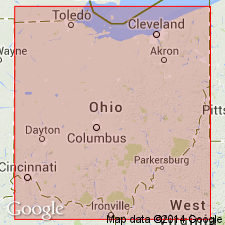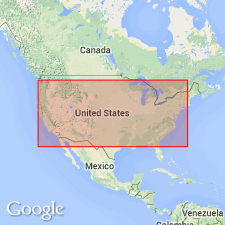
- Usage in publication:
-
- Erie shale
- Modifications:
-
- Original reference
- Dominant lithology:
-
- Shale
- AAPG geologic province:
-
- Cincinnati arch
- Appalachian basin
Summary:
Pg. 20. Erie shale. Bluish or greenish shales, 400 feet thick in northern Ohio; absent in central Ohio. Topmost formation of Devonian in northern Ohio. Overlain by black bituminous Cleveland shale and underlain by Huron shale.
Named from exposures on shores of Lake Erie from mouth of the Vermillion, [Erie Co.], to Dunkirk, [Hardin Co.], northern OH.
[GNC remark (US geologic names lexicon, USGS Bull. 896, p. 696): †Erie shale. Name preoccupied. Replaced by Chagrin shale. See entry under Prosser, 1903 (Jour. Geol., v. 11, p. 521).]
Source: US geologic names lexicon (USGS Bull. 896, p. 696).

- Usage in publication:
-
- Erian series
- Modifications:
-
- Revised
- AAPG geologic province:
-
- Appalachian basin
Summary:
Erian series, Middle Devonian. Comprises (ascending) Cazenovia, Tioughnioga, and Taghanic (Taughannock) stages. Follows Ulsterian series and precedes Senecan series.
Source: US geologic names lexicon (USGS Bull. 896, p. 694-695).
For more information, please contact Nancy Stamm, Geologic Names Committee Secretary.
Asterisk (*) indicates published by U.S. Geological Survey authors.
"No current usage" (†) implies that a name has been abandoned or has fallen into disuse. Former usage and, if known, replacement name given in parentheses ( ).
Slash (/) indicates name conflicts with nomenclatural guidelines (CSN, 1933; ACSN, 1961, 1970; NACSN, 1983, 2005, 2021). May be explained within brackets ([ ]).

